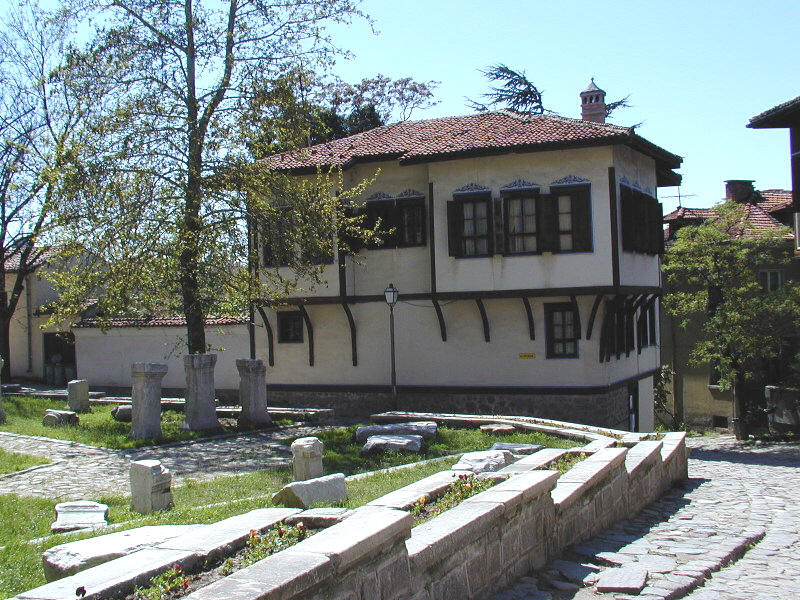 Old town of Plovdiv
Old town of Plovdiv
 |
Plovdiv
is one of the oldest cities in Europe. It is a
contemporary of Troy and Mycenae. It is older than Rome,
Athens, Carthage or Constantinople. Archaeologists have
discovered fine pottery[2]
and other objects of everyday life from as early as the
Neolithic Age, showing that in the end of the 7th
millennium B.C there already was an established
settlement there. According to
Ammianus Marcellinus, Plovdiv's written post-Bronze
Age history lists it as a
Thracian fortified settlement named Eumolpias. In
342 BC, it was conquered by
Philip II of Macedon, the father of
Alexander the Great, who renamed it "Φιλιππόπολις",
Philippopolis or "the city of Philip" in his own
honour. Later, it again became independent under the
Thracians, until its incorporation into the
Roman Empire, where it was called Trimontium
(City of Three Hills) and served as metropolis
(capital) of the province of
Thrace. Thrimontium was an important crossroad for
the Roman Empire and was called "The largest and most
beautiful of all cities" by
Lucian. In those times, the
Via Militaris (or
Via Diagonalis), the most important military road in
the
Balkans, passed through the city.[1]
The Roman times were a glorious period of growth and
cultural excellence. The ancient ruins tell a story of a
vibrant, growing city with numerous public buildings,
shrines, baths, and theatres. Many of those are still
preserved and can be seen by the curious tourist wishing
to experience the charm of ancient Rome up close ...
Full
article here... Source:
Wikipedia
More pictures here:
Nikola Gruev's Photo Album - Old Town of Plovdiv
|
|
|
Arbanasi (Bulgarian:
Арбанаси, also transliterated as Arbanassi) is a
village in
Veliko Tarnovo Province of Northern
Bulgaria, set on a high plateau between the larger
towns of
Veliko Tarnovo (4 km away) and
Gorna Oryahovitsa. It is known for the rich history
and large number of historical monuments, such as
medieval churches and examples
Bulgarian National Revival architecture, which have
turned it into a popular tourist destination.
The village's
name comes from the
Greek word Αλβανικος or Αλβανος, which, like
Turkish arnavut, was used to denote
Albanians and other people that came from parts of
Macedonia and
Albania that had a large Albanian population,
regardless of nationality.
The earliest written
document that marks the beginning of Arbanasi's history is a royal
decree by the
Ottoman
sultan
Suleiman the Magnificent from
1538,
according to which the sultan offered the lands of the modern
settlements of Arbanasi, Lyaskovets, Gorna Oryahovitsa and Dolna
Oryahovitsa to his
son-in-law
Grand Vizier Rustem Pasha as a gift. The four villages are united
under the name arnabud karielari in the document ...
Full
article here... Source:
Wikipedia
More pictures here:
Nikola
Gruev's Photo Album - Arbanasi
|
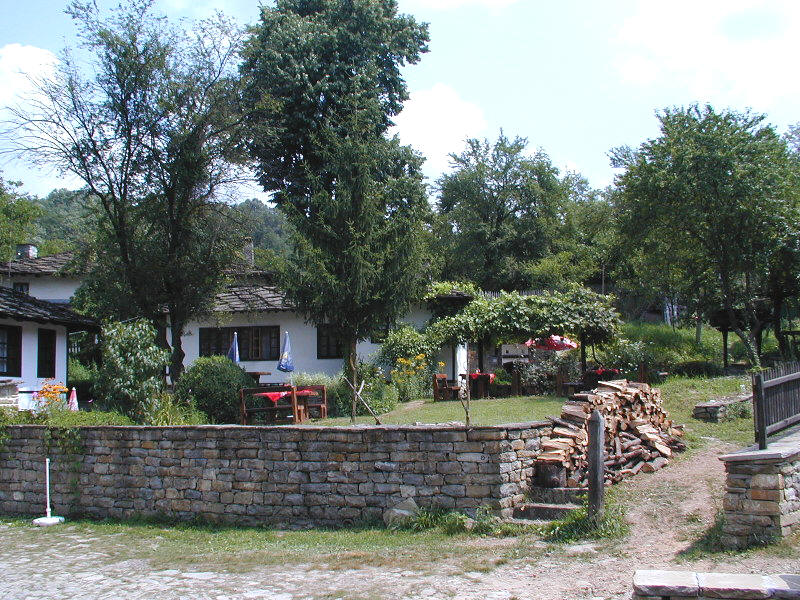 View of Bozhentsi
View of Bozhentsi
 |
Bozhentsi
(Bulgarian:
Боженци; also
variously transliterated as Bozhenci, Bojenci,
Bojenzi, Boženci, Bojentsi, Bojentzi, Bozhentzi,
etc.), officially but not commonly Bozhentsite (Боженците),
is a village and architectural reserve in
Gabrovo municipality,
Gabrovo Province, in central northern
Bulgaria. The village lies in the middle part of the
Balkan Mountains, 15 km east of Gabrovo and just
north of the
Shipka Pass. It is noted for its well-preserved
Bulgarian National Revival architecture and history,
and is thus a well-known tourist destination in the
area.
Bozhensti was established after the incursion of
Ottoman Turks in
Veliko Tarnovo, the former capital of the
Second Bulgarian Empire, in the 16th century. Many
residents of the capital then flew to settle in remote
and secure parts of the mountains. According to the
legend, among them was the young female noble (bolyarka)
Bozhana, who chose to hide in the area where the village
today is, and gave it its name. The noble's sons engaged
in trade and the village gradually grew to become an
important trade junction during the National Revival
towards the middle of the 18th century. The main
production consisted of leather, wool, beeswax and
honey.
The village of Bozhentsi was proclaimed an
architectural and historical reserve in 1964 and is part
of
UNESCO's cultural monuments ...
Full
article here... Source:
Wikipedia.
More pictures here:
Nikola
Gruev's Photo Album - Bozhentsi
|
 Old town of Sozopol
Old town of Sozopol
 |
Sozopol (Bulgarian:
Созопол;
Greek: Σωζόπολη, Sozópoli,
Turkish: Süzebolu) is a
small ancient town located 30
km
south of
Burgas on the southern
Bulgarian Black Sea Coast. Today the town is mostly a seaside resort
known for the Apollonia art and film festival named after one of
Sozopol's ancient names.
Sozopol is
one of the oldest towns on
Bulgarian Thrace's
Black Sea coast. The first settlement on the site
dates back to the
Bronze Age. Undersea explorations in the region of
the port reveal relics of dwellings, ceramic pottery,
stone and bone tools from that era. Many anchors from
the second and first millennium BC have been discovered
in the town's bay, a proof of active shipping since
ancient times.
The town, at first called Antheia, was
colonized in Thrace on the shore of the Pontus Euxinus,
principally on a little island, by
Anaximander (born 610-609 BC) at the head of
Milesian colonists. The name was soon changed to
Apollonia, on account of a temple dedicated to
Apollo in the town, containing a famous colossal
statue of the god Apollo by
Calamis, 30 cubits high, transported later to Rome
by
Lucullus and placed in the
Capitol. At various times, Apollonia was known as
Apollonia Pontica (that is, Apollonia on the
Black Sea, the ancient Pontus Euxinus) and
Apollonia Magna (Great Apollonia) ...
Full
article here... Source:
Wikipedia
More pictures here:
Nikola Gruev's Photo Album - Old town of Sozopol
|
|
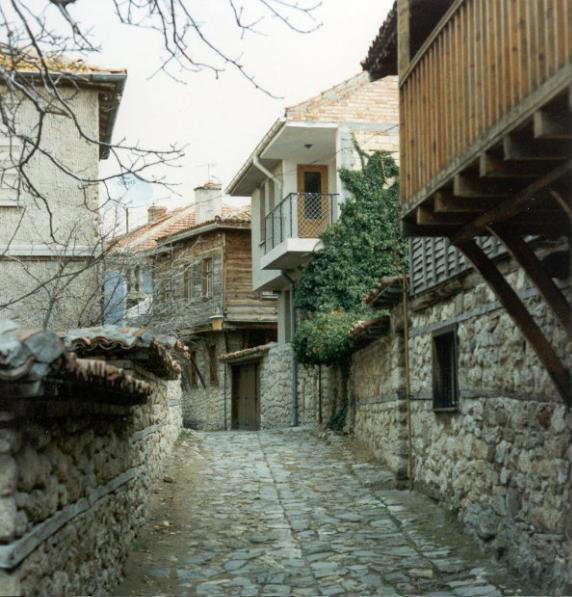
Old Town
of Nesebar
 |
Nesebar (Bulgarian:
Несебър, Nesebăr, though other transliterations
are also used), previously known as Mesembria (Greek:
Μεσημβρια, Mesimvria) and before that as
Menebria, is an ancient city on the
Black Sea coast of
Bulgaria, located in
Nesebar municipality,
Burgas Province.
Originally a
Thracian settlement known as
Menebria founded in the 2nd
millennium BC, the town became a
Greek colony when settled by
Dorians from
Megara at the beginning of the 6th
century BC, and was an important trading
centre from then on and a rival of
Apollonia (Sozopol).
Remains from the
Hellenistic period include the
acropolis, a temple of
Apollo, and an
agora. A wall which formed part of
the Greek fortifications can still be
seen on the north side of the peninsula.
Bronze and silver coins were minted in
the city since the 5th century BC and
gold coins since the 3rd century BC.
The town fell under
Roman rule in 71 BC, yet continued
to enjoy privileges such as the right to
mint its own coinage. It was one of the
most important strongholds of the
Byzantine Empire from the 5th
century AD onwards, and was fought over
by
Byzantines and
Bulgarians, being captured in 812 by
Khan Krum after a two week siege
only to be ceded back to Byzantium by
Knyaz
Boris I in 864 and reconquered by
his son Tsar
Simeon the Great. During the time of
the
Second Bulgarian Empire it was also
contested by Bulgarian and Byzantine
forces and enjoyed particular prosperity
under Bulgarian tsar
Ivan Alexander (1331-1371) until it
was conquered by
Crusaders led by
Amadeus VI, Count of Savoy in 1366
and handed back to Byzantium. The Slavic
version of the name, Nesebar or
Mesebar, has been attested since
the 11th century ...
Full
article here... Source:
Wikipedia
More pictures here:
Nikola
Gruev's Photo Album - Old town of Nesebar
|

Traditional taverns in a narrow street of Bansko

|
Bansko (Bulgarian:
Банско) is a town
in southwestern
Bulgaria, located at the foot of
Pirin at an altitude of 1936
m above sea level. Today it is a popular mountain
resort. Bansko is the birthplace of 20th century
Bulgarian poet
Nikola Vaptsarov and Bulgarian enlighteners
Paisiy Hilendarski (sometimes disputed) and Neofit
Rilski.
The archeological traces of the
inhabitants of Bansko and the
Razlog Valley in general date to the
early periods of the
Roman Empire.
There are
several housing structures at the outskirts of the town,
which date to
100 BC. However, there is no consensus nor credible
theory on who these people were.
Until
5 October
1912, Bansko was a part of the
Ottoman Empire, but enjoyed a quasi self-rule
autonomy granted by the sultan. The town was ruled by an
assembly of the elders, while justice was administered
by the Turkish judge in
Razlog. It was incorporated in Bulgaria in 1912 as a
result of the
First Balkan War.
Full
article here... Source:
Wikipedia
More pictures here:
Nikola
Gruev's Photo Album - Bansko
|
|
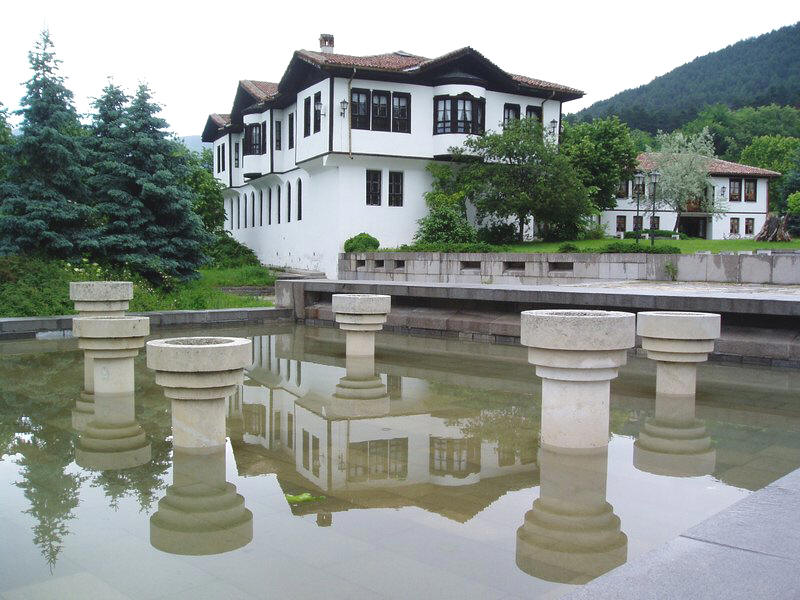
View of Kalofer
 |
|
|
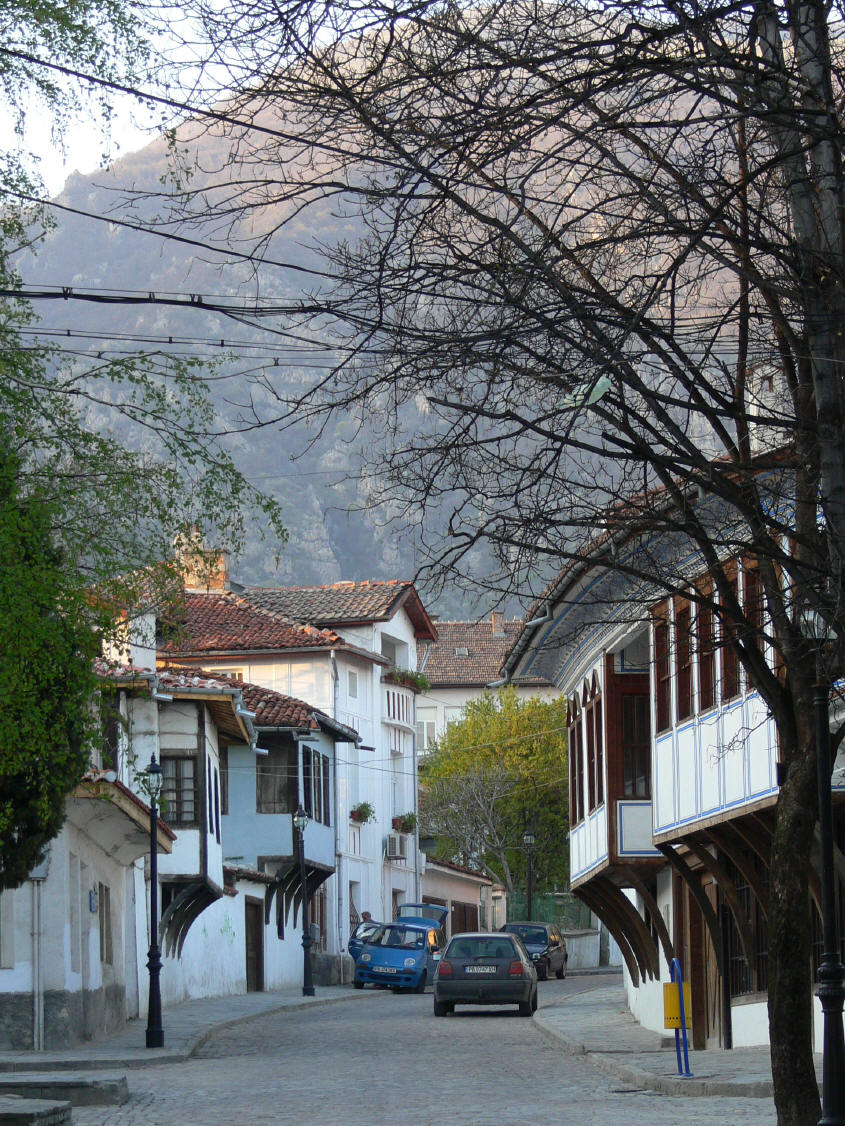
View of Karlovo
 |
Karlovo (Bulgarian:
Карлово) is a town
in central
Bulgaria located in a fertile valley along the river
Stryama at the southern foot of the
Balkan Mountains. It is administratively part of
Plovdiv Province and has a population of about
28,321 (as
of 2005), the mayor being Emil Kabaivanov of the
UDF.GRBulgaria
Karlovo lies at
42°38′N 24°48′E, 386 m above sea level.
Karlovo is famous for the
worldwide-known
rose oil, which is grown there and used in producing
perfume. In addition to this, Karlovo is the birthplace
of
Vasil Levski, the most distinguished Bulgarian to
start preparing the national liberation from the
Ottoman rule in the late 19th century. There is a
museum and large monument dedicated to him. Karlovo is
also a popular location for tourism in the region.
The town originated in the 14th
century, but grew in importance in the 19th century as a
centre of Bulgarian culture and revolutionary activity.
During the 2000s, Bulgarian
archaeologists made discoveries in Central Bulgaria
which were summarized as "The Valley of the
Thracian Kings". On 19 August 2005, some
archaeologists announced they had found the first
Thracian capital, which was situated near Karlovo in
Bulgaria. A lot of polished ceramic artifacts (pieces of
roof-tiles and Greek-like vases) were discovered
revealing the fortune of the city. The Bulgarian
Ministry of Culture declared its support to the
excavations.
Source:
Wikipedia, the free Encyclopedia
|
|
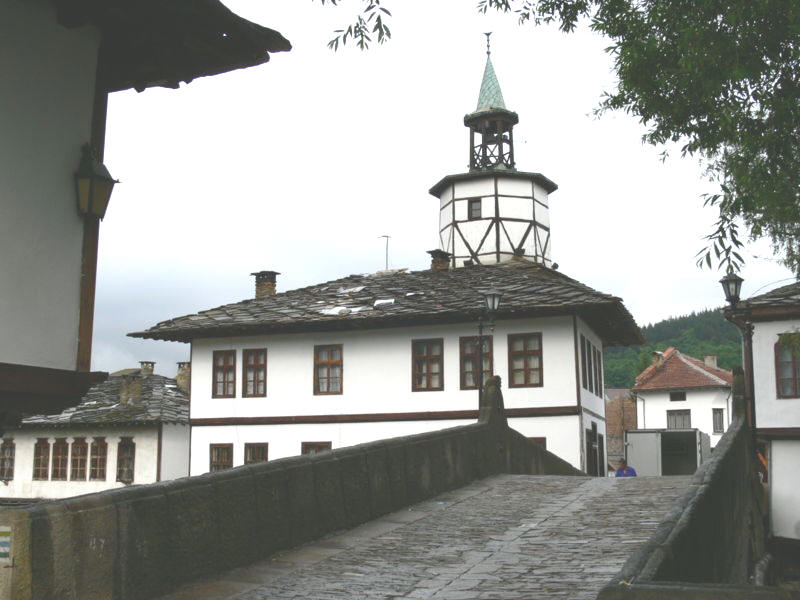
View of Tryavna
 |
Tryavna
(Трявна) is a town in central
Bulgaria, situated in the north slopes of the Balkan
range, on the Tryavna river valley, near
Gabrovo. It is famous for its
textile industry and typical National Revival
architecture, featuring 140 cultural monuments, museums
and expositions. Tryavna is the birthplace of Bulgarian
writer
Pencho Slaveykov and revolutionary
Angel Kanchev. The village was founded as early as
the Thracian Era. However, the first documents of its
existence date back to the 12th century. During
Ottoman Bulgaria period locals defended the pass and
enjoyed privileges for this reason. Only Bulgarians
lived in the town; the Turks never gained access in it.
During the period of Bulgarian national revival, the
town was heavily involved in the development of crafts.
Houses from this period feature their own architectural
design. The ground floors had irregular forms and housed
craftsmen and traders. The upper floors featured wooden
bow-windows, the roofs were covered with well arranged
rocks.
The town Square, named
Capitan Diado Nikola, with the clock tower, dating
from 1814, are among the landmarks. Another tourist
attraction is the "kivgireniyat" bridge, built above the
river behind the clock tower. In the Capitan Diado
Nikola Square has been built one of the first secular
schools in Bulgaria. Another symbol of Tryavna is the
St. Archangel Mihael Church, situated in the town
center and built in the late 12th century after
bulgarian tzar Asen defeated byzanthine emperor Isaac
II.
Full
article here... Source:
Wikipedia
|
|

View of Panagyurishte
 |
Full
article and more pictures you can find here ... Source:
Wikipedia



 |
|
|
|
|
©2008
Bulgaria
Emil Manchev
![]() |


















